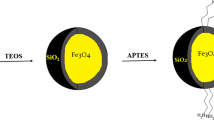Abstract
Magnetic separation technology was applied in the separation of flavonoids from the licorice root in this work. Licorice flavonoids (LF) displayed a remarkable array of biological and pharmacological activities. The magnetic adsorbents with functional —NH2 groups were synthesized by immobilization of amino-silane on the surface of the magnetic silica supports, which were prepared by co-precipitation method. The adsorption and desorption characteristics of the magnetic adsorbents for the separation of LF have been evaluated. The purity of an enriched extract with this method was 16.7% while the crude extract only had about 6.8% purity. Therefore, it can be concluded that these kinds of magnetic adsorbents have selectivity to the flavonoids to some extent. The affinity selectivity of the adsorbents is based on the formation of hydrogen bonding between the —NH2 on the magnetic adsorbents and —OH, —CO on the flavonoids.
Similar content being viewed by others
References
Hatano T, Aga Y, Shintani Y, Ito H. Minor flavonoids from licorice. Phytochemistry, 2000, 55: 959–963
Fukai T, Marumo A, Kaitou K. Anti-Helicobacter pylori flavonoids from licorice extract. Life Sci, 2002, 71: 1449–1463
Van Beek T A. Chemical analysis of Ginkgo biloba leaves and extracts. J Chromatogr A, 2002, 967: 21–35
Tamir S, Eizenberg M, Somjen D, Izraela S, Vaya J. Estrogen-like activity of glabrene and other constituents isolated from licorice root. J Steroid Biochem, 2001, 78: 291–298
Kimura M, Inoue H, Hirabayash K, Natsume H, Ogihara M. Glycyrrhizin and some analogues induce growth of primary cultured adult rat hepatocytes via epidermal growth factor receptors. Eur J Pharmacol, 2001, 43: 151–161
Yokozawa, Dong T. Antioxidant activity of flavones and flavonols in vitro. Phytother Res, 1997, 11: 446–449
Cao Y H, Wang Y. Determination of liquirigenin and isoliquirigenin in Glycyrrhiza uralensis and its medicinal preparalions by capillary eleetrophoresis with electmchemjcal detection. J Chromotogr A. 2004, 1042: 203–209
Kumda M. Phenolics with PPAR. Ligand-banding activjtity obtained from licorice (Glycyrrhiza Uralensis roots) and amelioratire efectsa of glycn oil genetically diabetic KK-A mice. Bioorganic Med Chem Letter, 2003, 13: 4267–4272
Rijke E D, Out P, Niessen W M A, Ariese F, Gooijer C, Brinkman U A T. Analytical separation and detection methods for flavonoids. J Chromatogr A, 2006, 1112: 31–63
Fu B Q, Liu J, Li H, Li L, Lee Frank S C, Wang X R. The application of macroporous resins in the separation of licorice flavonoids and glycyrrhizic acid. J Chromatogr A, 2005, 1089: 18–24
Molday R S. Application of magneticmicrospheres in labeling and separation. Nature, 1977, 268: 437–438
Luk J M C, Lindberg A A. Rapid and sensitive detection of Salmonella by immunomagnetic monoclonal antibody-based assays. J Immunol Methods, 1991, 137: 1–8
Cupta P K, Hung C T. Magnetically controlled targeted micro-carrier systems. Life Sci, 1989, 44: 175–186
O’Brien S M, Thomas O R T, Dunnill P. Non-porous magnetic chelator supports for protein recovery by immobilized metal affinity adsorption. J Biotechol, 1996, 50: 13–15
Hoyos M, McCloskey K E, Moore L R, Nakamura M, Bolwell B J, Chalmers J J, Zborowski M. Pulse-injection studies of blood progenitor cells in a quadrupole magnet flow sorter. Separ Sci Techol, 2002, 37: 745–767
Guan Y P, Liu H Z, An Z T, Ke J J. CN Patent No. ZL 98124516.1 (in Chinese), 1998
Lu X, Fu Y J, Wang W, Zu Y G. Determination of flavonoids in Glycyrrhiza Uralensis Fisch. With ultraviolet spectrophotometry. Bull Botanical Res (in Chinese), 2003, 23: 192–194
Aehle E, Raynaud-Le Grandic S. Development and evaluation of an enriched natural antioxidant preparation obtained from aqueous spinach extract by an adsorption procedure. Food Chem, 2004, 86: 579–585
Zhang G D, Guan Y P, Shan G T, Liu H Z. Surface modification of Fe3O4 nano particles and its application in preparation of magnetic alumina catalyst supports. Chin J Process Eng, 2002, 2: 319–324
Lu Y, Yin Y D, Mayers B T. Modifying the surface of superpara-magnetic iron oxide nanoparticles through a sol-gel approach. Nano Lett, 2002, 2: 183–186
Ma Z Y, Guan Y P, Liu H Z. Superparamagnetic silica nanoparticles with immobilized metal affinity ligands for protein adsorption. J Magn Magn Mater, 2006, 301: 469–477
Ma M, Zhang Y, Yu W, Shen H Y, Zhang H Q, Gu N. Preparation and characterization of magnetite nanoparticles coated by amino silane. Colloid Surface A. 2003, 212: 219
Saravanan L, Subramanian S. Surface chemical studies on the competitive adsorption of poly (ethylene glycol) and ammonium poly(methacrylate) onto alumina. J Colloid Interf Sci. 2005, 284: 363
Author information
Authors and Affiliations
Corresponding authors
Additional information
Supported by the National High Technology Research and Development Program of China (Grant No. 2002AA302211) and the National Science Fund for Creative Research Groups of China (Grant No. 20221603)
Rights and permissions
About this article
Cite this article
Zhang, B., Xing, J., Lang, Y. et al. Synthesis of amino-silane modified magnetic silica adsorbents and application for adsorption of flavonoids from Glycyrrhiza uralensis Fisch. Sci. China Ser. B-Chem. 51, 145–151 (2008). https://doi.org/10.1007/s11426-007-0104-y
Received:
Accepted:
Issue Date:
DOI: https://doi.org/10.1007/s11426-007-0104-y




